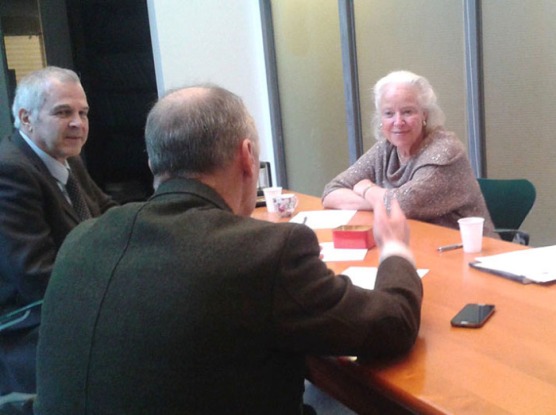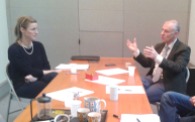
Lieutenant-Colonel Régis Prunet of the Firefighters’ Brigade
Par Cécilia de Vulpian
Security Made to Order
The operating style of Régis Prunet, which is exemplary in my opinion, is that he works in close partnership with state-appointed managing architects for historic monuments and with the national historic monument inspection services. “To each his own” does not mean “every man for himself.”
CDV: COLONEL, YOU ARE LIEUTENANT-COLONEL OF THE BRIGADE OF FIREFIGHTERS, YET YOU WORK AT THE MINISTRY OF CULTURE. CAN YOU EXPLAIN THIS TO US?
In fact, in 1990, the Ministry of Culture created an officer’s post for a firefighter to consult on fire safety in historic buildings, schools of architecture, and archeological sites. The legislative texts on historic buildings do not directly address fire safety. At the same time, most designated historic monuments are subject either to regulations for facilities receiving the public, to regulations in employment law texts, or to regulations for tall buildings, all of which is subject to control by the security commissions overseen by the Ministry of the Interior.
My role is to go a bit further than the security commission, which focuses on security for the public or for employees, in order to work to specifically to protect historic buildings.
For example, I was recently asked to go to the Château de La Motte-Tilly for a temporary exhibition including works on loan from Versailles and the Louvre. To accomplish this with complete security and safety*, my police commander colleague and I go to conduct verifications on-site. We might propose to add fire detection devices or security officers if we judge the level of safety and security to be insufficient for important works, even if public safety is already covered by the applicable standards for facilities receiving the public.
At the Ministry, I am systematically called upon by the historic monument inspectors when there are questions concerning major monuments, but also by regional curators who are called upon to give recommendations on work permits, whether by the state architects for historic monuments or by the Architectes des Bâtiments de Francesince they must address the expectations of safety commissions. The situation arises where installing safety lighting as one might do in a new building will have an impact on an historic structure. When an exemption is requested to preserve the aesthetics of a place, we have to find solutions to reach an equivalent level of safety. We try to be a force for proposals.
CDV: DO YOU OFTEN FEEL YOUSELF TO BE “CAUGHT BETWEEN TWO BATTLES”?
Exactly! And that is indeed my role. The commission will require very restrictive conditions in order to ensure public safety, while theArchitecte des Bâtiments de France, the curator, or the state historic-monuments architect will be trying to best protect the building and its aesthetics. Sometimes the two are not compatible. I am thus between the two, familiar with both. So a sort of facilitator. Over three years’ time, we have also put in place a training unit at the firefighting academy on the subject of “How to Integrate Fire Safety in an Historic Monument”. Firefighters must complete continuing education every three years, so we have already impacted more than 2000 of those who are on the ground daily. So there has been a good deal of progress in the way of looking at things.
CDV: WHAT ARE THE MAIN CAUSES OF FIRES IN HISTORIC MONUMENTS? AND WHAT ARE THE RECOMMENDED PROTECTION MEASURES?
Of first priority are out-of-date electrical systems and what is done with them. An old system used in an “old-fashioned” way does not pose a problem. Short-circuiting on old systems is caused by extension cords, microwaves, or computers that pull too much power. Next, lightning is a frequent cause of fires, and, finally, while work is being done, essentially work using heated tools. When, for example, on a roof renovation, a blow torch is used to solder lead next to very old roof structure, very dry, or when copper is heated it can conduct heat toward inflammable or explosive materials, creating a hazardous situation.
Fortunately, when this type of work is done in France, a fire permit must be requested. This supposes an inspection before, during, and after the work activity. But sometimes, one spark going into a crack in a piece of wood just before the weekend is enough to start a fire.
It is important to evaluate the causes, but also the conditions in a building which unfortunately favor the spreading of a fire. Among the materials currently available, hemp is being used more and more because it is a material respectful of the environment, but it very easily catches fire. Or for another example, when walls are removed in the attic of an old building to pass heating or air-conditioning ducts, this creates an ideal situation for the propagation of fire. Pressure builds in the space, gases are formed, and then only a small amount of air needs to be introduced and the who thing is set ablaze. I have seen cases where a simple door was enough to avoid the spreading of gases and, therefore, of fire. When it can be done, it is recommended to create separations between the spaces.
CDV: HOW DOES ONE PUT OUT A FIRE IN AN HISTORIC MONUMENT?
The answer varies depending on the country. In Canada, for example, the question is hardly asked: six months of the year, with the snow, firefighters have difficulty intervening. So they use sprinklers. In France, where response time is more rapid, we can offer ourselves the luxury of reflecting on the subject on a case-by-case basis. One has to analyze what one wants to protect and how.
For very sensitive situations, such as reserves of artworks or archives, one can consider using automatic fire extinction with rare gases such as Inergen or Argon. But in that case, it is necessary to evacuate the premises to avoid being poisoned.
Otherwise, some interesting solutions are being developed in Germany. They involve using a sort of permanent anoxyde. The system sends nitrogen to lower the oxygen threshold below 14%. A fire cannot break out at such a low oxygen level. Employment law regulations forbid the use of this system in France. However, in the mountains the oxygen level descends below 14% without causing a problem. This could be done in depositories of artworks where there is no workspace.
In facilities receiving the public, where automatic fire extinction is used, there is an effort to replace spraying with misting water. The National Archives building at Pierrefitte-sur-Seine is the first tall building for which the safety commission has approved the installation of water mists. This will give firefighters time to arrive before the fire spreads. Thus, the archives will be practically be undampened.
CDV: WHERE DOES ONE DRAW THE BOUNDARY BETWEEN REGLEMENTATIONS AND AESTHETICS AND WHAT SOLUTIONS EXIST TO ENSURE SAFETY WITHOUT DENATURING THE BUILDING?
The boundaries change continually. For facilities receiving the public, the regulations allow for waiver requests. For example, regulations require emergency exit signage blocks and dedicated emergency lighting blocks. These are going to have an impact on the building, so we look for solutions. The state historic monument architects search for more discreet blocks to better integrate in the space. On can go even further. At Versailles, at the Château de Maisons-Lafitte, in Notre-Dame Cathedral, the lighting fixtures have been equipped with another safety system.
They keep their regular power circuits but are equipped with a second safety circuit which is set off in the event of a loss of current in the regular one. This modification in the lighting fixtures is a way to meet the public safety objective without negatively impacting the place.
The Château de Haut-Koenigsbourg in Alsace is situated on a rocky peak at an altitude of 800 meters. Access is therefore difficult, especially in winter. We estimate a 30-minute delay for the arrival of firefighters in the event of a fire in the upper rooms. Water pressure was low and subject to freezing. Enormous work was undertaken to excavate the stone and create a water reserve. Then, to overcome the threat of freezing, we installed valves with a pre-action system on the pipes. Thanks to significant work carried out by a firefighter with a passion for historic preservation and the state architect for historic monuments, the entire pipe system is integrated into the décor and the safety lighting is barely visible; the firefighters have an emergency escape map in case of fire.
In the rooms under the Mont Saint-Michel, the security commission approved dimmed lighting to preserve the spirit of the place, on the condition of adding additional lighting connected to the fire detection system. This is exceptional. In the older districts of cities, one does not talk about buildings but whole blocks of buildings! Fire spreads and can ravage a whole block. The problem is guaranteeing access for firefighters. Each case is specific, whether it be Rennes, Nice, or Bayonne, for example. In these old districts, buildings are not subject to the rules for facilities receiving the public because they are most often residential. So the owners are pretty much free to do what they want. In the protected sector of Rennes, apartments in 16th– and 17th-century buildings have been divided up, stairways closed, apartments raised up. Large apartments which originally had staircases accessible to firefighters have become inaccessible in the event of a fire. In Rennes there was collaborative work to study the problems on a case-by-case basis shared by the city administration, historic preservation agencies, and firefighters. And often when the preservation architect was satisfied, the firefighter was as well, because in restoring a building to its original state, firefighter access was improved. In Nice a similar approach is taken, but the situation there is quite different because the buildings had small interior courtyards where firefighters were unable to bring in their ladders. The firefighters therefore have a whole pre-established plan for intervention. In Bayonne, they did remarkable work finding evacuation solutions for the small interior courtyards without negatively impacting the character of the buildings. These little courtyards had glass roofs which posed an additional difficulty. The result of this work on preserving the sector and bringing it up to standard is admirable.
*The French terms “sécurité” and “sureté” are distinct. “Sureté” refers to protection from intruders and concerns Mr. Prunet’s colleague, the police commander.









